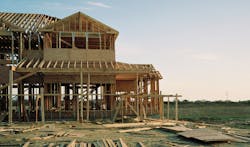NAHB Economist Addresses Housing Construction During 'Viral Economic Stress'
Viral Economic Stress
The last two weeks have seen growing concern and economic stress related to coronavirus mitigation efforts and social distancing. These recommended strategies will continue to place large sections of the U.S. economy on pause for at least the next few weeks — and potentially much longer. Postponed events, cancelled travel plans and deferred service consumption all represent lost economic activity. With a growing number of individuals altering their work schedules and working from home, construction and manufacturing are experiencing disruptions as well.
NAHB is forecasting in our baseline model that second quarter GDP growth will be markedly negative, likely posting the worst performance since the third quarter of 2008. Approximately 40 percent of the economy is on a full or partial pause due to the coronavirus. Assuming that such efforts are successful within an eight-week period (consistent with South Korea's experience, where data are reliable), we forecast a weak third quarter followed by a rebound at the end of 2020. The unemployment rate will certainly rise in the months ahead from its historically low rate of 3.5%. Furloughs and layoffs are already being announced in heavily impacted sectors.
• While this 2020 downturn will be sharp, it may also be short.
• For the economy as a whole, while the short-term outlook is negative, policy help is underway.
• For the construction sector, key challenges exist and vital questions remain.
While this 2020 downturn will be sharp, it may also be short. The economy was in solid shape at the start of 2020, which was particularly true for housing. The March measure of the NAHB/Wells Fargo Housing Market Index showed a healthy sentiment reading of 72, despite a two-point drop from February. The April reading will certainly be lower due to current market conditions. Single-family home construction in February was up almost 7% from an already strong pace in January, as warm weather accelerated 2020 construction activity.
For the economy as a whole, while the short-term outlook is negative, policy help is underway. The Federal Reserve dramatically reduced the federal funds rate to effectively zero, restarted quantitative easing (including for mortgage-backed securities, when the mortgage market signaled some liquidity concerns at the end of last week), and made other policy moves to help ensure the continued operation of the financial system. President Trump and Congress are negotiating an aggressive stimulus bill, perhaps totaling $1 trillion, which is intended to help the economy bridge the gap from March to August.
For the construction sector, key challenges exist and vital questions remain: To what degree will permit approvals, engineering inspections, and building supply chains continue or be disrupted? Will stimulus policies enable rents and mortgage payments to continue? How will the labor market respond to a national health crisis and social distancing? This is uncharted territory, and NAHB's economics group will continue to survey the industry, analyze the data and support the policy work of NAHB on behalf of the industry. All things considered, history suggests a robust rebound will follow this significant but temporary shock to the economy.
— Robert Dietz, Chief Economist, NAHB
